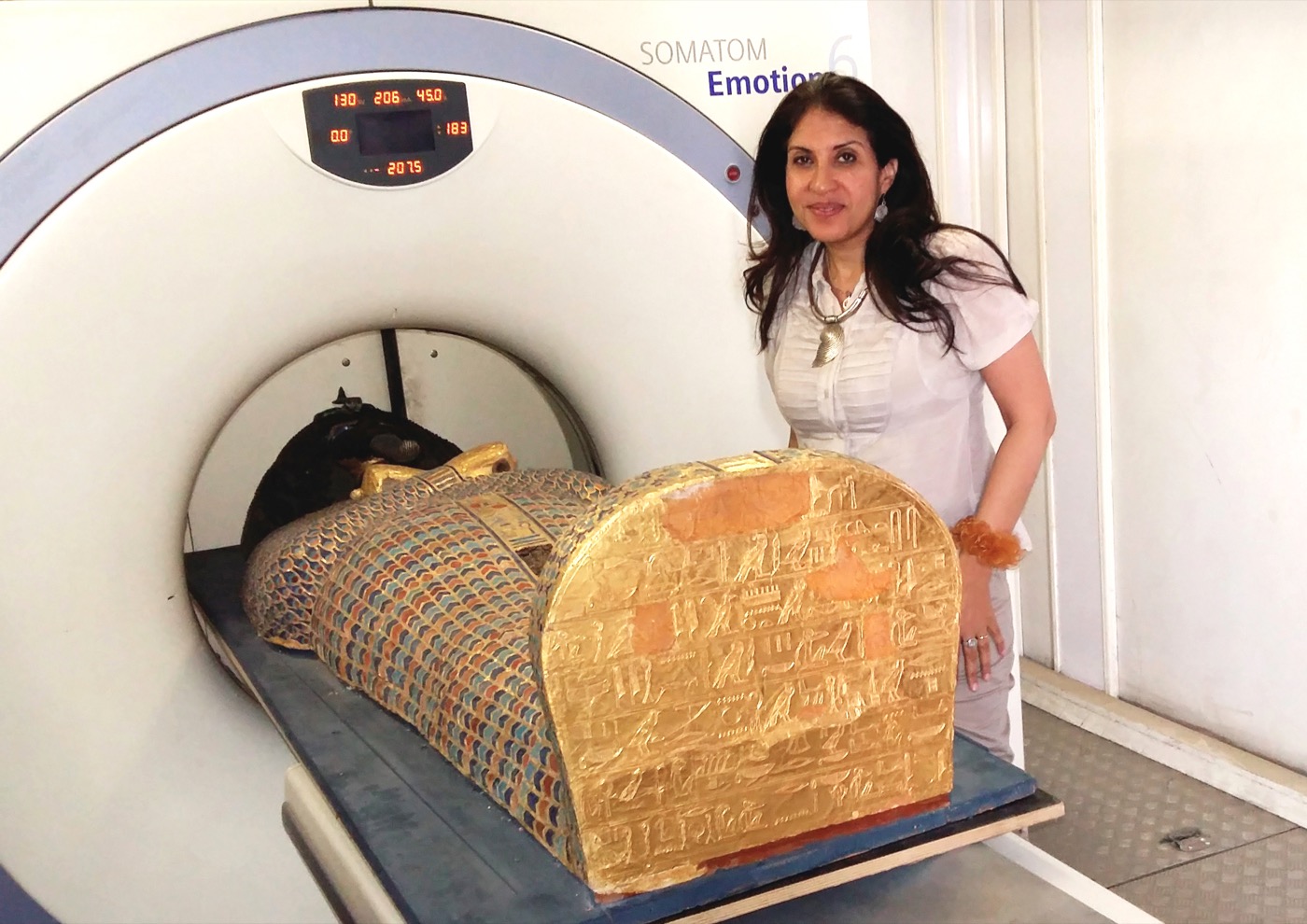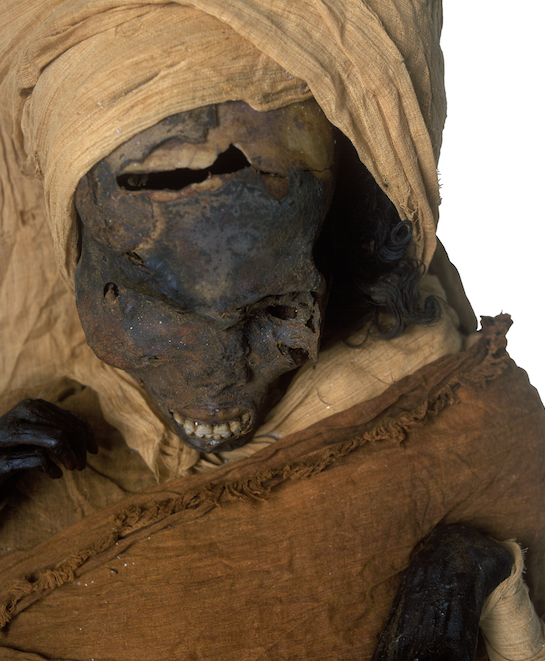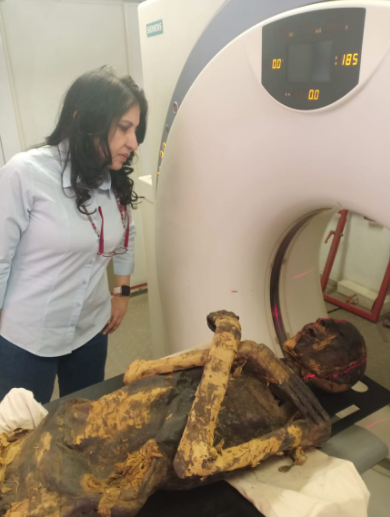Uncovering An Ancient Mummy Mystery
8:08 minutes

Ever since the discovery of King Seqenenre-Taa-II’s mummy in Egypt in the mid-1800s, it was clear that the king had met an untimely demise. His hands were clenched in a claw-like gesture, and the pharaoh’s head bore several fatal wounds. But the exact nature of his death was lost to time: Had he died in some sort of palace intrigue? Or was he executed?
Writing in the journal Frontiers in Medicine, radiologist Sahar Saleem and her collaborators argue that a CT scan of the mummy supports the theory that the king died during conflict with the Hyksos, an Asian group that invaded and controlled northern Egypt. The researchers say that the wounds and other signs on the body suggest the king was captured, bound, and executed by multiple assailants.
SciFri’s Charles Bergquist spoke with Saleem about her research, and how it fills in clues about the ancient mystery.


Invest in quality science journalism by making a donation to Science Friday.
Sahar Saleem is a professor of Radiology in the Faculty of Medicine at Cairo University in Cairo, Egypt.
IRA FLATOW: For the rest of the hour, a trip to ancient Egypt and a mystery. Picture the mummy of an Egyptian pharaoh, what do you see? The sarcophagus, right? And then inside, the remains themselves, carefully wrapped with the arms peacefully crossed over the chest in preparation for the afterlife.
But in Egypt’s Royal Gallery of Mummies, there is one mummy that stands out. And now there’s new research into why. Here with that is SciFri’s Charles Bergquist. Hi, Charles.
CHARLES BERGQUIST: Hey, Ira.
IRA FLATOW: So what’s so different about this mummy?
CHARLES BERGQUIST: Well, if you go to this museum gallery, the remains of Seqenenre the Second, also called Seqenenre the Brave, aren’t arranged as neatly as the others. His hands are raised and sort of like claws. And his head is covered with wounds.
IRA FLATOW: Like from an attack?
CHARLES BERGQUIST: The thought is the wounds are definitely signs of some kind of foul play. Back in the 1960s, scientists took x-rays of the mummy, and there’s evidence of multiple cuts and blows to the head.
IRA FLATOW: So what do they think really did happen here?
CHARLES BERGQUIST: The question is still open on exactly what might have happened to this king over 3,000 years ago. Was he killed in some kind of palace intrigue? Was he executed?
IRA FLATOW: Well, was he?
CHARLES BERGQUIST: Well, it’s a good question. Sahar Saleem is a radiologist in the Faculty of Medicine at Cairo University. She recently took a new look at the remains using a CT scanner to hunt for new evidence into this mystery. I had a chance to talk with her about what she found. Put this king into context for us. Where does he fit in the Egyptian lineage?
SAHAR SALEEM: Seqenenre the Second, known as The Brave, he ruled Egypt in the 17th dynasty, about 200 years before Tutankhamun. And this was the time during the occupation of the a group of [? Asian ?] shepherds, known as the Hyksos. They ruled Egypt actually for a century. And they took a city in the north called out Avaris to be their capital. The Egyptians, though, maintained power over the south, yet all Egypt had to pay tribute to the Hyksos So this how powerful they were– those invaders.
CHARLES BERGQUIST: And there’s a story that I was reading that the immediate cause of the conflict between the king and the Hyksos was hippopotamuses making too much noise?
SAHAR SALEEM: At the time of [INAUDIBLE] the Hyksos King– his name was Apophis. And he actually he sent a very bad language message to Seqenenre, mentioning that to the hippopotamuses in the sacred lake making noise annoyed them. And he demanded they should be killed.
Where the hippopotamuses were to the King Apophis, they were about 600 kilometers. So there is no way that they were doing that. And we don’t have the full message because the end of the papyrus was ruined.
But the part that we have, it ended that Seqenenre, he called his advisors. And this is a sort of an indication that he’s preparing for war. Seqenenre was actually well prepared to fight and to expel Hyksos. I do believe that he just took this letter of Apophis as an excuse to start the war.
CHARLES BERGQUIST: This is Science Friday from WNYC Studios. In case you’re just joining us, I’m talking with radiologist Sahar Saleem about what happened to Egypt’s ancient King Seqenenre the Second. What was it that made you want to study his remains?
SAHAR SALEEM: He was on the top of the list for the mummies that we want to study because we don’t have any clues related to the history and whether he really fought Hyksos or not, how he died. So we want to know, what is his story?
CHARLES BERGQUIST: So through the CT imaging you were able to get a much better picture of the condition of the remains and the wounds that were on them. What did you find?
SAHAR SALEEM: Yeah, we found severe head injuries. And we have weapons related to the Hyksos weapons. So I matched the Hyksos weapons– different Hyksos weapons– with the injuries I found in the CT scan in Seqenenre. So this will give us an idea that he died in a combat and not for example, in his palace, in a conspiracy, as other theories claimed.
But there is something else. There were no other injuries in the body. Only the injuries were focused on the head. If somebody is attacking the defense, the natural reflex will be this person will try to defend his face by his arm. So usually the forearm would have some sort of injuries or fractures.
But this did not happen. With the deformity of the hands and with the absence of the fractures, we came to the conclusion that the King’s hands were tied together. So he was bound. And likely, his hands were tied behind his back. This all give the circumstances of his death in a battle and probably that he was captured before being executed by several attackers, using several weapons.
CHARLES BERGQUIST: So is there something more to learn here, beyond just this question of how the King was killed?
SAHAR SALEEM: Something important about Seqenenre that we didn’t know in history– that he was a renowned warrior. Other were known to be warriors. For example, Ramses the Second, Thutmose the Third. And despite that, we couldn’t find any injuries in their mummies– those reputable warriors– to indicate that they have been in the front line of a battle.
But for Seqenenre, although the history mentioned nothing about him being a warrior, it is very clear that he was in the front line of the battlefield with his soldiers. Science and modern science can help rewriting stories and help giving credit to real heroes, that even the history mentioned nothing about them. But now it’s about time to give credit to Seqenenre that he really deserves.
CHARLES BERGQUIST: Thank you so much for taking the time to talk about this with me.
SAHAR SALEEM: You too. Thank you.
CHARLES BERGQUIST: Dr. Sahar Saleem is a professor of radiology in the Faculty of Medicine at Cairo University. And you can see pictures of some of her research and a link to the paper on our website at sciencefriday.com/mummymystery. For Science Friday, I’m Charles Bergquist.
Copyright © 2021 Science Friday Initiative. All rights reserved. Science Friday transcripts are produced on a tight deadline by 3Play Media. Fidelity to the original aired/published audio or video file might vary, and text might be updated or amended in the future. For the authoritative record of Science Friday’s programming, please visit the original aired/published recording. For terms of use and more information, visit our policies pages at http://www.sciencefriday.com/about/policies/
As Science Friday’s director and senior producer, Charles Bergquist channels the chaos of a live production studio into something sounding like a radio program. Favorite topics include planetary sciences, chemistry, materials, and shiny things with blinking lights.